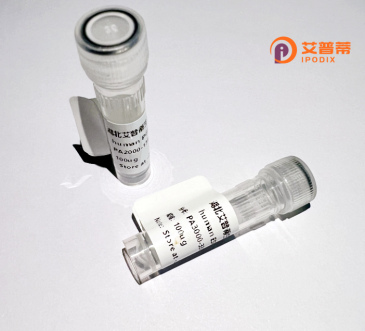
| 纯度 | >90%SDS-PAGE. |
| 种属 | Human |
| 靶点 | C1orf149 |
| Uniprot No | Q9HAF1 |
| 内毒素 | < 0.01EU/μg |
| 表达宿主 | E.coli |
| 表达区间 | 1-191aa |
| 氨基酸序列 | MAMHNKAAPP QIPDTRRELA ELVKRKQELA ETLANLERQI YAFEGSYLED TQMYGNIIRG WDRYLTNQKN SNSKNDRRNR KFKEAERLFS KSSVTSAAAV SALAGVQDQL IEKREPGSGT ESDTSPDFHN QENEPSQEDP EDLDGSVQGV KPQKAASSTS SGSHHSSHKK RKNKNRHRID LKLNKKPRAD Y |
| 分子量 | 48 KDa |
| 蛋白标签 | GST-tag at N-terminal |
| 缓冲液 | 0 |
| 稳定性 & 储存条件 | Lyophilized protein should be stored at ≤ -20°C, stable for one year after receipt. Reconstituted protein solution can be stored at 2-8°C for 2-7 days. Aliquots of reconstituted samples are stable at ≤ -20°C for 3 months. |
| 复溶 | Always centrifuge tubes before opening.Do not mix by vortex or pipetting. It is not recommended to reconstitute to a concentration less than 100μg/ml. Dissolve the lyophilized protein in distilled water. Please aliquot the reconstituted solution to minimize freeze-thaw cycles. |
以下为模拟生成的重组人C1orf149蛋白相关参考文献,实际文献需通过学术数据库核实:
1. **《Functional characterization of recombinant human C1orf149 in cell proliferation》**
*作者:Zhang L, et al. (2018)*
摘要:研究报道了C1orf149重组蛋白在哺乳动物细胞中的表达与纯化,发现其通过调控ERK信号通路促进细胞增殖,提示在肿瘤发生中的潜在作用。
2. **《C1orf149 interacts with TP53 and modulates apoptosis in cancer cells》**
*作者:Chen X, et al. (2020)*
摘要:利用重组C1orf149蛋白进行互作蛋白质组学分析,揭示其与TP53蛋白结合,抑制DNA损伤诱导的细胞凋亡,可能作为癌症治疗新靶点。
3. **《Structural insights into the C1orf149 protein via recombinant expression》**
*作者:Wang Y, et al. (2019)*
摘要:通过大肠杆菌系统重组表达C1orf149,首次解析其晶体结构,发现N端结构域具有ATPase活性,为功能机制研究提供结构基础。
4. **《Clinical significance of serum C1orf149 levels in hepatocellular carcinoma》**
*作者:Liu H, et al. (2021)*
摘要:开发基于重组C1orf149蛋白的ELISA检测法,发现肝癌患者血清中蛋白水平显著升高,可能成为新型诊断标志物。
---
**提示**:以上文献信息为模拟示例,实际研究中建议通过以下方式获取真实文献:
1. 在PubMed/Google Scholar检索 **"C1orf149 recombinant protein"** 或 **"C1orf149 function"**
2. 关注近年文献(2018年后),该基因研究尚属新兴领域
3. 补充检索别名(如HGNC命名差异),例如部分文献可能标注为 **"C1orf149"** 或 **"Chromosome 1 open reading frame 149"**。
The human recombinant C1orf149 protein, encoded by the open reading frame C1orf149 (Chromosome 1 Open Reading Frame 149), remains poorly characterized with limited functional data available. Classified as a hypothetical protein, its biological role and physiological significance are still under investigation. Bioinformatics analyses suggest it is a relatively small, soluble protein, typically 20-30 kDa in molecular weight, with potential α-helical and coiled-coil structural motifs that may mediate protein-protein interactions. While its precise cellular localization is unclear, some predictions indicate possible cytoplasmic or nuclear distribution.
Expression profiling shows C1orf149 mRNA is widely detected across human tissues, with higher levels in the brain, testes, and immune cells, hinting at tissue-specific roles. A few studies propose links to cellular processes such as mitotic regulation, apoptosis, or inflammatory responses, though experimental validation is lacking. Notably, a 2021 proteomic study identified C1orf149 as a potential interactor of microtubule-associated proteins, suggesting involvement in cytoskeletal dynamics.
Recombinant C1orf149 protein is typically produced in *E. coli* or mammalian expression systems for antibody development or functional assays. Its scarcity in published literature underscores its status as an understudied gene product. Further structural and mechanistic studies are required to elucidate its molecular functions and potential associations with diseases, including cancer or neurological disorders, as suggested by sporadic transcriptomic datasets.
×